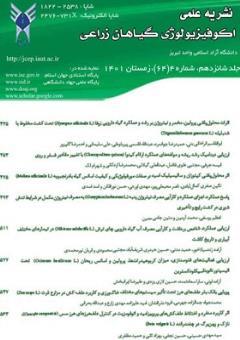Determination of Suitable Irrigation Schedule Adapted to Plant Phenology for Seed Production of Berseem Clover (Trifolium alexandrinum L.) in North of Khuzestan Province
Subject Areas : Journal of Crop Ecophysiologyاحمدعلی شوشی دزفولی 1 * , mohammad khorramian 2 , سید احمد کلانتر احمدی 3 , سید حسین محمودی نژاد دزفولی 4
1 - ستادیار پژوهش بخش تحقیقات فنی مهندسی و کشاورزی، مرکز تحقیقات کشاورزی و منابع طبیعی صفیآباد، سازمان تحقیقات،
آموزش و ترویج کشاورزی،
2 - irrigation researcher
3 - مرکز تحقیقات کشاورزی صفی آباد (دزفول)
4 - مرکز تحقیقات و آموزش کشاورزی و منابع طبیعی صفی آباد
Keywords: Berseem clover, Deficit irrigation, Forage crops, Seed harvesting.,
Abstract :
Berseem clover (Trifolium alexandrinum L.) is one of the forage plants that can play an important role in adjusting the planting pattern and crop rotation. The North of Khuzestan is the most important area for the production of Berseem clover seeds in Iran and irrigation scheduling (IS) has a key role in Berseem clover seed production. In order to determine the most suitable irrigation based on the phenology of Berseem clover and its effect on seed yield, an experiment was conducted as a randomized complete block design with 6 treatments and 3 replications in Safiabad Agricultural Research and Education and Natural Resources Center in cropping season 2019-2020. Treatments were applied based on irrigation or cessation irrigation at the beginning of flowering and maximum flowering, and then applying irrigation from the time of maximum flowering to seed maturity based on 80 or 120 mm evaporation from the class A evaporation pan. Results showed that the irrigation schedules had a significant effect on the total weight dry matter of forage production, clover straw yield (seed harvesting time), thousand seeds weight, number of inflorescences per square meter, seed yield and water productivity of Berseem clover (P˂0.05). The results showed that imposing drought stress at the start of flowering and irrigation at the maximum of this stage as well as that irrigation after 80 mm evaporation from a class A evaporation pan between maximum flowering until seed maturity is suitable irrigation program to achieve the optimal seeds (1237 kg.ha-1) of Berseem clover and also the optimal consumption of irrigation water (3521 m3.ha-1). It was also found that the maximum flowering stage in Berseem clover is the critical stage in terms of water in seed production fields, and the elimination of irrigation in this stage leads to decrease in Berseem clover seed yield by 50%.
• Alizadeh, A. 2020. Irrigation system design. Volume 1. Ferdowsi University of Mashhad Press. 456 pp. (In Persian).
• Allen, R.G., L.S. Pereira, D. Raes, and M. Smith. 1998. Crop Evapotranspiration (guidelines for computing crop water requirements) No.56. FAO Irrigation and Drainage Paper. 300 pp.
• Azizi, K.H. 2003. Influence of agro technical factor on seed bank in soil, establishment and natural self-regeneration of annual medics and reserve of soil moisture. Ph. D Thesis. Tarbiat Modaress University, Iran.125 pp. (In Persian).
• Clinton C.S., B.F.G. Erik, D.S. Lamont, and J. Clauzer. 2007. Deficit irrigation for optimum Alfalfa seed yield and quality. Agronomy Journal. 99(4): 992-998.
• Hanson, A.A., D.K. Barnes, and P.R. Hill. 1988. Alfalfa and Alfalfa Improvement. P.B. Madison, wisconson. U.S.A. 1084 pp.
• Khorramian, M, and A.A. Shoushi Dezfuli. 2008. Effects of irrigation regimes and row spacing on alfalfa seed yield in the North of Khuzestan. Seed and Plant Journal. 24(2): 295-308. (In Persian).
• Lannucci, A., and P. Martinello. 1997. Analysis of seed yield components in four Mediterranean annual clovers. Field Crops Research. 55(2): 235-243.
• Lannucci, A., M. Rascio, M. Russo, N. Difanzoand, and P. Martiniello. 2000. Physiological responses to water stress following a conditioning period in berseem clover. Plant and Soil. 223(1-2): 219-229.
• Russo, N., S. Difanzoand, and P. Martiniello. 2000. Physiological responses to water stress following a conditioning period in berseem clover. Plant and Soil. 223(1-2): 219-229.
• Martiniello, P. 1999. Effect of irrigation and harvest management on dry matter yield and seed yield of annual clovers grown in pure stand and in mixtures with graminaceous species in Mediterranean environment. Grass and Forage Science. 54(1): 52-61.
• Martin, R.J., R.N. Gillespie, and R.N. Mayley. 2003. Effect of timing and intensity of drought on the seed yield of white clover (Trifolium repens L.). In solutions for a better environment: Proceedings of the 11th Australian Agronomy Conference. Published as a CD. pp: 172-174.
• Oliva, R.N., J.J. Steiner, and W.C. Young. 1994a. White clover seed production. II. Soil and Plant water status on yield and yield components. Crop Science. 34(3):768-774.
• Oliva, R.N., J.J. Steiner, and W.C. Young. 1994b. Red clover seed production: II. Plant water status on yield and yield components. Crop Science. 34(1):178-184.
• Pacetti, L., R. Usi., M. Romani, P. Fraschini, and M. Sadis. 2012. Evaluation of berseem clover (Trifolium alexandrinum L.) germplasm in Sardina, Italy. Italian Journal of Agronomy. 7(28):203-213.
• Shoushi Dezfuli, A.A., M. Khorramian, and A. Assareh. 2019. Effect of Sowing and Irrigation Cutoff Date on Seed Yield and Irrigation Water Use Efficiency of Spring Berseem Clover in Khouzestan. Journal of Plant Productions. 41(4): 69-82. (In Persian).
• Sinha, N.C. and R.P. Singh. 1986. Physiological basis of irrigation scheduling for seed production in Egyption clover syn. Berseem (Trifolium alexandrnium L.). Journal of Agronomy and Crop Science. 156(4): 246-252
• Taylor, N.L. 1985. Clover science and technology. Americans Society of Agronomy, Inc, Madison, Wisconsin, U.S.A. pp : 417- 421.

